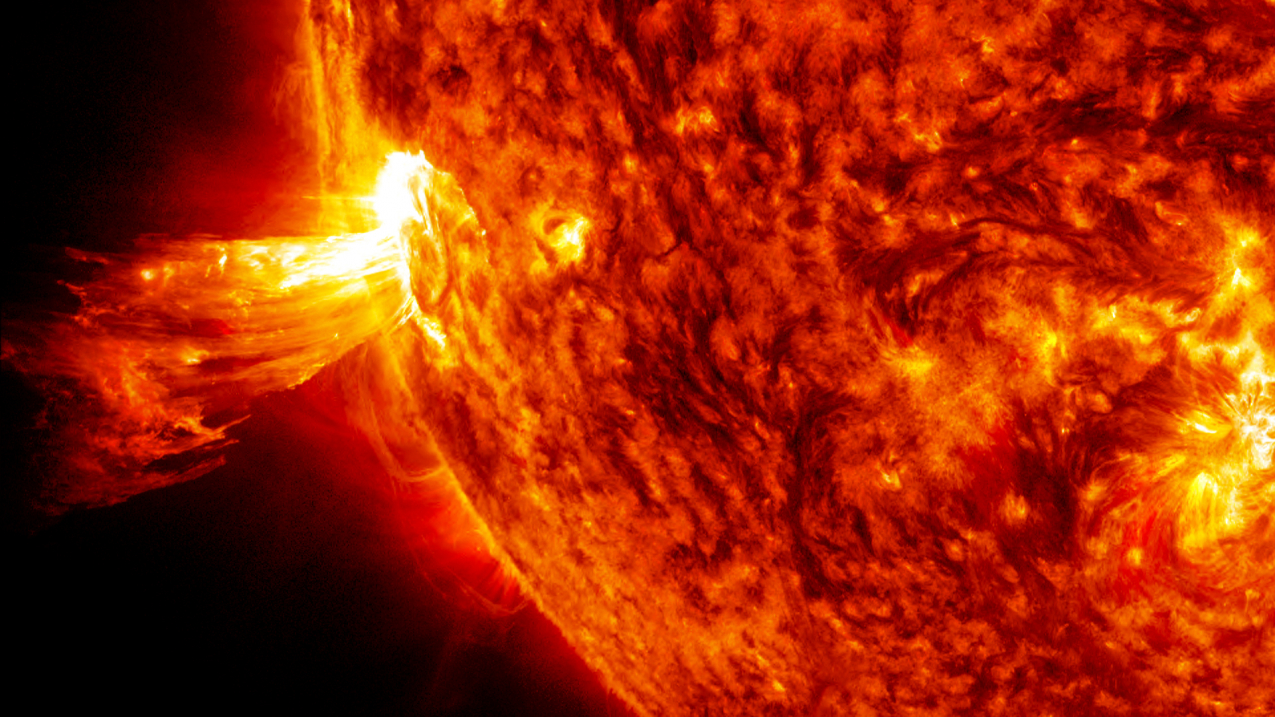
Powerful eruption from the surface of the sun captured on June 20, 2013. (Image credit: NASA)
Space weather: Storms from the Sun
Solar storms can disrupt technologies on Earth
Eruptions from the Sun can disrupt technology
Forecasters keep an eye on the Sun 24/7
The solar cycle
Eruptions from the Sun’s surface can cause space weather storms that affect technology here on Earth.
The Sun is the center of the solar system and the most important energy source for life on Earth. From time to time, the Sun emits bursts of radiation, high-speed electrons and protons, and other highly energetic particles into space — phenomena known as space weather. If a large burst is directed at Earth, these particles and radiation can disrupt the technologies we depend upon. These storms have the potential to interfere with radio transmitters, satellite operations and communications, navigation and GPS, and the electric power grid.
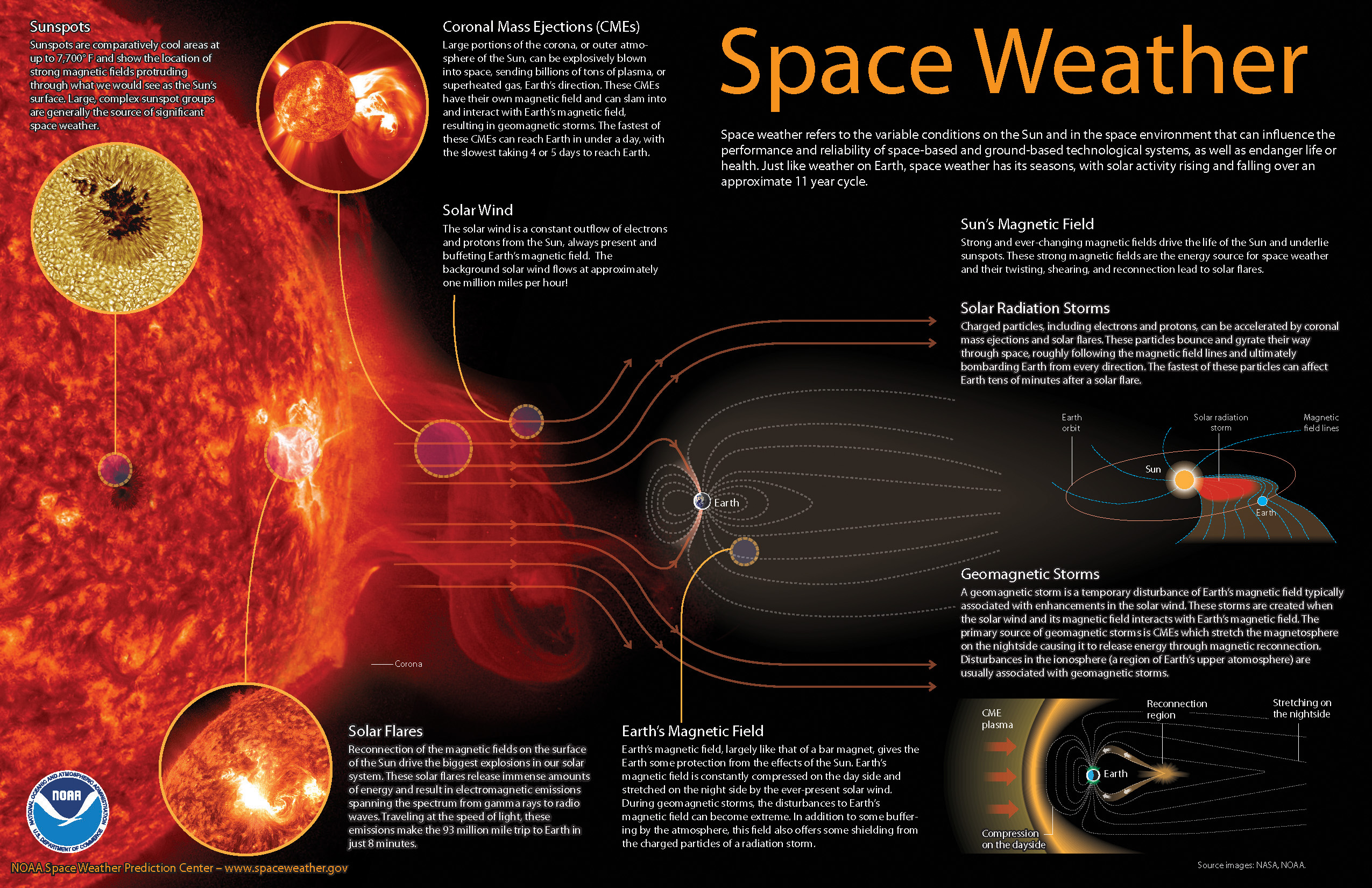
1989
—The year a solar storm sent Quebec into darkness/knocked out power for 9 hours.
As conditions develop, forecasters at NOAA’s Space Weather Prediction Center issue space weather alerts, watches, and warnings to inform its users — electric grid operators, satellite operators, airlines and more — about what to expect, so they can take action and protect infrastructure and the public.
Although rare, these strong geomagnetic storms, can require voltage corrections by power grid operators and may trigger protection devices similar to a circuit breaker. Extreme geomagnetic storms can damage high-voltage power transformers, causing damage that could take days, weeks, or even longer to be repaired, depending on the size of the power grid.
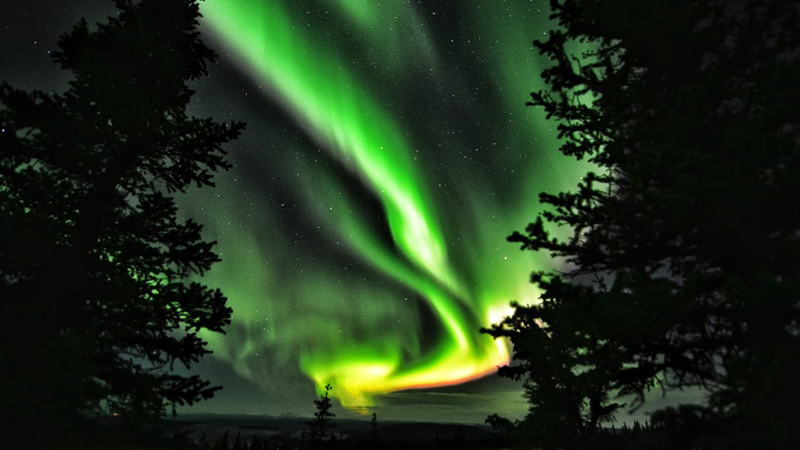
Space weather can also produce spectacular aurora borealis (northern and southern lights). These colorful beams of dancing lights, typically seen moving across the polar skies, are the result of electrons colliding with the upper reaches of the Earth’s atmosphere. Here’s the current aurora forecast, issued by NOAA’s Space Weather Prediction Center.
Our nation’s security, economic vitality, and daily functioning depend on the reliable operations of satellites and aircraft, communications networks, navigation systems, and the electric power grid. As these technologies and infrastructures become increasingly interdependent, the world faces greater risks from space weather events.
In 2013, Lloyds of London predicted that the most extreme space weather storms could affect 20-40 million people in the U.S. and cause up to $2.6 trillion in damages, with recovery taking up to two years.
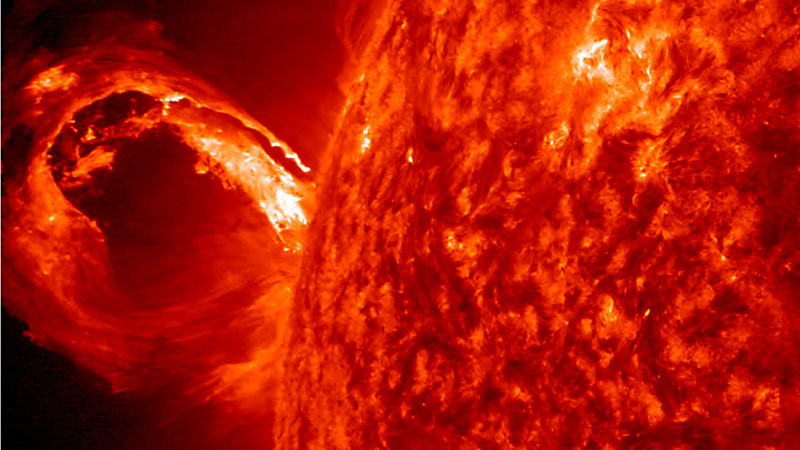
There are different types of space weather events, and each can affect different technologies. Solar flares degrade high-frequency radio communication on the sunlit side of the Earth, causing radio blackouts. Flares can also be accompanied by radio emissions that can interfere with GPS and other satellite communications.
High-energy particles (protons and electrons) released during flares, can penetrate satellite electronics and cause malfunctions. During significant solar radiation storms, airlines may suspend transpolar flights to avoid degraded navigation and communications. International Space Station astronauts may have to take precautions during extreme events.
Coronal mass ejections (CMEs) are giant blobs of plasma which erupt from the Sun. If they arrive at Earth, they can cause geomagnetic storms. Rare but significant storms can lead to blackouts, such as the 1989 event that plunged Quebec into darkness for nine hours. Most of the time, however, geomagnetic disturbances are much less dramatic and easily dealt with by power grid operators.
Space weather is common, and generally invisible to the average person, except when geomagnetic storms cause beautiful aurora. However, industries affected by space weather have to plan for these events to ensure the reliability of their products and services. Users of space weather information include satellite operators, electric utilities, airlines, oil drilling companies, precision agriculture, and federal agencies.
Space Weather Impact Examples
- 1859 (Late August-early September): The Carrington Event, named for astronomer Richard Carrington who observed the solar flare preceding an historic geomagnetic storm. The storm disrupted telegraph communications around the world and produced aurora seen as far south as Hawaii and Central America. offsite link
- 1989 (March): Quebec plunged into darkness for 9 hours as power grid overwhelmed by geomagnetic storm. offsite link
- 2003 (October): “Halloween Storms” resulted in a 30 hour outage of the Federal Aviation Administration’s Wide Area Augmentation System (WAAS), which provides GPS navigation support to aircraft. offsite link
- 2005 (January): United Airlines diverted 26 flights from polar routes to avoid radio blackout potential. offsite link
- 2013 (March): Three separate CME arrivals in March resulted in three separate satellite outages lasting from hours to days. offsite link
NOAA’s Space Weather Prediction Center (SWPC) is the nation’s official source for space weather watches, warnings and alerts. Forecasters there provide real-time monitoring and forecasting of solar and geophysical events, so organizations can protect individuals and infrastructure from solar storms.
Space weather forecasts, like forecasts for weather on Earth, begin with observations. These observations are collected from a variety of platforms, including spacecraft, like the NOAA’s GOES satellites, and ground-based solar and magnetic observatories. Forecasters monitor the emergence and development of sunspots, the production of solar flares and particle events, and the eruption of large blobs of plasma called coronal mass ejections (CMEs). Each of these phenomena can impact technology in space and on Earth in different ways. The NOAA Space Weather Scales give the type and intensity of space weather impacts, and many SWPC products refer to these scales.
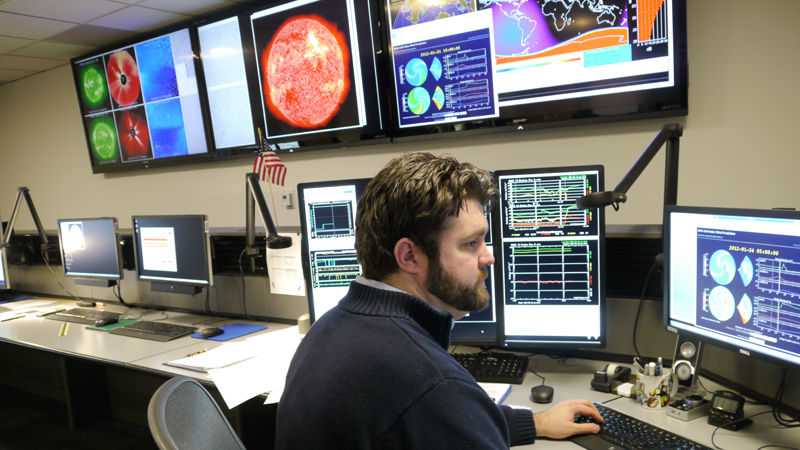
|
Minor - Extreme |
|||||
|---|---|---|---|---|---|
|
Geomagnetic Storms: Disturbances in the geomagnetic field caused by coronal mass ejections and high speed solar wind streams. Associated with disruptions in electrical systems, satellites, GPS, and radio systems; deliver beautiful auroras. |
G1 |
G2 |
G3 |
G4 |
G5 |
|
Solar Radiation Storms: Elevated levels of radiation that occur when the numbers of energetic particles increase. Can be a danger to the health of astronauts and to people flying at high altitudes in high latitudes; may temporarily interfere with satellites and radio systems. |
S1 |
S2 |
S3 |
S4 |
S5 |
|
Radio Blackouts: Disturbances of the ionosphere caused by solar flares. May cause high frequency communication outages on the sunlit side of the Earth. Radio bursts from the sun can interfere with GPS signals. |
R1 |
R2 |
R3 |
R4 |
R5 |
Know the Terms
- Watches are used for making long-lead (days) predictions of geomagnetic activity.
- Warnings are used to raise the public's level of alertness based on an expectation that a space weather event is imminent (hours to minutes).
- Alerts indicate that the observed conditions, highlighted by the warnings, have crossed a preset threshold or that a space weather event has already started.
NOAA improves space weather forecasts by introducing new products and models into the forecast office
The Deep Space Climate Observatory (DSCOVR) spacecraft, stationed between the Sun and Earth at Lagrange Point 1, was launched in February 2015 and is set to become America’s primary warning system. Instruments onboard will provide critical solar wind data and enable accurate detection and forecasting for approaching CMEs.
Unlike terrestrial weather, the use of numerical prediction models for space weather forecasts is in its infancy. The WSA-Enlil model is one example and is used to determine when and if a CME will arrive at Earth. Another model, called Geospace, is planned for operational use in late 2016. This model will provide a variety of new products aimed at characterizing the impact of geomagnetic storms on a particular region, as well as the day-to-day variability of Earth’s magnetic field.
As NOAA continues to improve its models and forecasts, we also play a critical role in working with our federal partners to protect, mitigate, respond to, and recover from the potentially devastating effects of space weather. Learn more about the National Space Weather Strategy and Action Plan.
Sign up today for space weather email alerts, warnings, watches from NOAA.
The solar cycle, also known as the sunspot cycle, is the natural, periodic change in the level of the Sun’s activity. The Sun alternates between solar maximum, when there is high activity on the Sun, to solar minimum, when there is very little activity. The solar cycle lasts 11 years on average.
Scientists track sunspots in part to determine our solar cycle status and project the duration of the cycle. Earth entered solar cycle 24 in 2008 and reached solar maximum — the period when the Sun is most active — in April of 2014. We are now on the downside of the cycle. The peak number sunspots was 81.9, lower than cycles in the recent past, but not unusual.

During the solar minimum, it is rare to see sunspots on the Sun, and the spots that do appear are usually small and short-lived. The next solar minimum is expected around 2019.
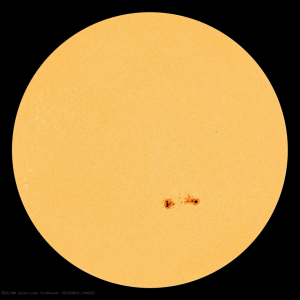
1755
—Year scientists started recording solar sunspot activity.
Understanding and predicting the solar cycle is important for determining the lifetime of satellites in low-Earth orbit, as the drag on the satellites correlates with the solar cycle. A higher solar maximum decreases satellite life and a lower solar maximum extends satellite life. Also, the prediction gives a rough idea of the frequency of radio blackouts, radiation storms, and geomagnetic storms. It is used by many industries to gauge the expected impact of space weather in the coming years.
Eruptions from the Sun’s surface can cause space weather storms that affect technology here on Earth.
The Sun is the center of the solar system and the most important energy source for life on Earth. From time to time, the Sun emits bursts of radiation, high-speed electrons and protons, and other highly energetic particles into space — phenomena known as space weather. If a large burst is directed at Earth, these particles and radiation can disrupt the technologies we depend upon. These storms have the potential to interfere with radio transmitters, satellite operations and communications, navigation and GPS, and the electric power grid.

1989
—The year a solar storm sent Quebec into darkness/knocked out power for 9 hours.
As conditions develop, forecasters at NOAA’s Space Weather Prediction Center issue space weather alerts, watches, and warnings to inform its users — electric grid operators, satellite operators, airlines and more — about what to expect, so they can take action and protect infrastructure and the public.
Although rare, these strong geomagnetic storms, can require voltage corrections by power grid operators and may trigger protection devices similar to a circuit breaker. Extreme geomagnetic storms can damage high-voltage power transformers, causing damage that could take days, weeks, or even longer to be repaired, depending on the size of the power grid.

Space weather can also produce spectacular aurora borealis (northern and southern lights). These colorful beams of dancing lights, typically seen moving across the polar skies, are the result of electrons colliding with the upper reaches of the Earth’s atmosphere. Here’s the current aurora forecast, issued by NOAA’s Space Weather Prediction Center.
Our nation’s security, economic vitality, and daily functioning depend on the reliable operations of satellites and aircraft, communications networks, navigation systems, and the electric power grid. As these technologies and infrastructures become increasingly interdependent, the world faces greater risks from space weather events.
In 2013, Lloyds of London predicted that the most extreme space weather storms could affect 20-40 million people in the U.S. and cause up to $2.6 trillion in damages, with recovery taking up to two years.

There are different types of space weather events, and each can affect different technologies. Solar flares degrade high-frequency radio communication on the sunlit side of the Earth, causing radio blackouts. Flares can also be accompanied by radio emissions that can interfere with GPS and other satellite communications.
High-energy particles (protons and electrons) released during flares, can penetrate satellite electronics and cause malfunctions. During significant solar radiation storms, airlines may suspend transpolar flights to avoid degraded navigation and communications. International Space Station astronauts may have to take precautions during extreme events.
Coronal mass ejections (CMEs) are giant blobs of plasma which erupt from the Sun. If they arrive at Earth, they can cause geomagnetic storms. Rare but significant storms can lead to blackouts, such as the 1989 event that plunged Quebec into darkness for nine hours. Most of the time, however, geomagnetic disturbances are much less dramatic and easily dealt with by power grid operators.
Space weather is common, and generally invisible to the average person, except when geomagnetic storms cause beautiful aurora. However, industries affected by space weather have to plan for these events to ensure the reliability of their products and services. Users of space weather information include satellite operators, electric utilities, airlines, oil drilling companies, precision agriculture, and federal agencies.
Space Weather Impact Examples
- 1859 (Late August-early September): The Carrington Event, named for astronomer Richard Carrington who observed the solar flare preceding an historic geomagnetic storm. The storm disrupted telegraph communications around the world and produced aurora seen as far south as Hawaii and Central America. offsite link
- 1989 (March): Quebec plunged into darkness for 9 hours as power grid overwhelmed by geomagnetic storm. offsite link
- 2003 (October): “Halloween Storms” resulted in a 30 hour outage of the Federal Aviation Administration’s Wide Area Augmentation System (WAAS), which provides GPS navigation support to aircraft. offsite link
- 2005 (January): United Airlines diverted 26 flights from polar routes to avoid radio blackout potential. offsite link
- 2013 (March): Three separate CME arrivals in March resulted in three separate satellite outages lasting from hours to days. offsite link
NOAA’s Space Weather Prediction Center (SWPC) is the nation’s official source for space weather watches, warnings and alerts. Forecasters there provide real-time monitoring and forecasting of solar and geophysical events, so organizations can protect individuals and infrastructure from solar storms.
Space weather forecasts, like forecasts for weather on Earth, begin with observations. These observations are collected from a variety of platforms, including spacecraft, like the NOAA’s GOES satellites, and ground-based solar and magnetic observatories. Forecasters monitor the emergence and development of sunspots, the production of solar flares and particle events, and the eruption of large blobs of plasma called coronal mass ejections (CMEs). Each of these phenomena can impact technology in space and on Earth in different ways. The NOAA Space Weather Scales give the type and intensity of space weather impacts, and many SWPC products refer to these scales.

|
Minor - Extreme |
|||||
|---|---|---|---|---|---|
|
Geomagnetic Storms: Disturbances in the geomagnetic field caused by coronal mass ejections and high speed solar wind streams. Associated with disruptions in electrical systems, satellites, GPS, and radio systems; deliver beautiful auroras. |
G1 |
G2 |
G3 |
G4 |
G5 |
|
Solar Radiation Storms: Elevated levels of radiation that occur when the numbers of energetic particles increase. Can be a danger to the health of astronauts and to people flying at high altitudes in high latitudes; may temporarily interfere with satellites and radio systems. |
S1 |
S2 |
S3 |
S4 |
S5 |
|
Radio Blackouts: Disturbances of the ionosphere caused by solar flares. May cause high frequency communication outages on the sunlit side of the Earth. Radio bursts from the sun can interfere with GPS signals. |
R1 |
R2 |
R3 |
R4 |
R5 |
Know the Terms
- Watches are used for making long-lead (days) predictions of geomagnetic activity.
- Warnings are used to raise the public's level of alertness based on an expectation that a space weather event is imminent (hours to minutes).
- Alerts indicate that the observed conditions, highlighted by the warnings, have crossed a preset threshold or that a space weather event has already started.
NOAA improves space weather forecasts by introducing new products and models into the forecast office
The Deep Space Climate Observatory (DSCOVR) spacecraft, stationed between the Sun and Earth at Lagrange Point 1, was launched in February 2015 and is set to become America’s primary warning system. Instruments onboard will provide critical solar wind data and enable accurate detection and forecasting for approaching CMEs.
Unlike terrestrial weather, the use of numerical prediction models for space weather forecasts is in its infancy. The WSA-Enlil model is one example and is used to determine when and if a CME will arrive at Earth. Another model, called Geospace, is planned for operational use in late 2016. This model will provide a variety of new products aimed at characterizing the impact of geomagnetic storms on a particular region, as well as the day-to-day variability of Earth’s magnetic field.
As NOAA continues to improve its models and forecasts, we also play a critical role in working with our federal partners to protect, mitigate, respond to, and recover from the potentially devastating effects of space weather. Learn more about the National Space Weather Strategy and Action Plan.
Sign up today for space weather email alerts, warnings, watches from NOAA.
The solar cycle, also known as the sunspot cycle, is the natural, periodic change in the level of the Sun’s activity. The Sun alternates between solar maximum, when there is high activity on the Sun, to solar minimum, when there is very little activity. The solar cycle lasts 11 years on average.
Scientists track sunspots in part to determine our solar cycle status and project the duration of the cycle. Earth entered solar cycle 24 in 2008 and reached solar maximum — the period when the Sun is most active — in April of 2014. We are now on the downside of the cycle. The peak number sunspots was 81.9, lower than cycles in the recent past, but not unusual.

During the solar minimum, it is rare to see sunspots on the Sun, and the spots that do appear are usually small and short-lived. The next solar minimum is expected around 2019.

1755
—Year scientists started recording solar sunspot activity.
Understanding and predicting the solar cycle is important for determining the lifetime of satellites in low-Earth orbit, as the drag on the satellites correlates with the solar cycle. A higher solar maximum decreases satellite life and a lower solar maximum extends satellite life. Also, the prediction gives a rough idea of the frequency of radio blackouts, radiation storms, and geomagnetic storms. It is used by many industries to gauge the expected impact of space weather in the coming years.


